Welcome back to the 2000AD Humble Bundle round-up! I’ve finally gotten a chance to sink my teeth into the rest of this comic book overload and have plenty of thoughts to share. If you missed part one then I would definitely recommend checking it out before reading this. With that said though, let’s dive right back in with a real banger…
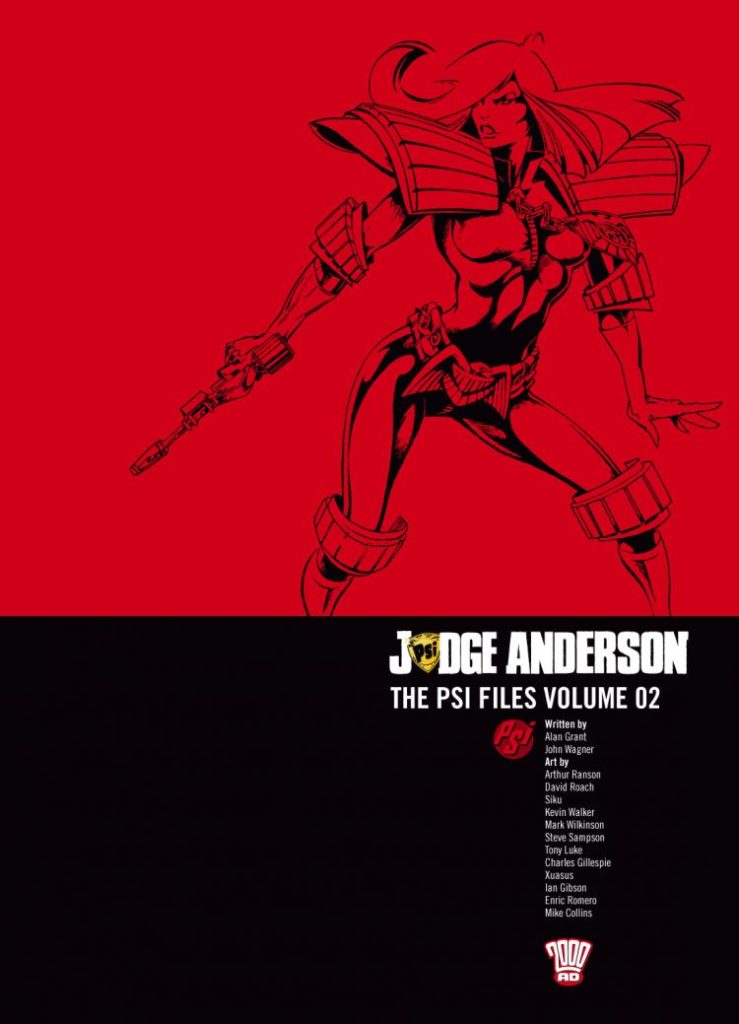
Judge Anderson: The Psi Files
Judge Dredd may be the poster-boy for 2000AD but I’d argue that Judge Anderson is the far more compelling judge character. Bizarrely, the Humble Bundle only includes volume two of Judge Anderson: The Psi Files, but luckily it is a compelling snapshot into what makes this character so great. The volume picks up in the wake of the tragic suicide of one of Judge Anderson’s friends and her final words haunt her throughout the entirety of the book: “People with gifts like ours shouldn’t use them for ugly things.” Unlike Dredd, Judge Anderson sees the judges for what they really are, oppressive fascists who make life worse for everyone and questions her role in propping up this system. The social commentary is pointed, including a story which is a blatant Rodney King analogy and which is just as relevant today and another which equates the judges with the Roman legionnaires who persecuted the early Christians. This refusal to just play along makes Anderson a far more radical and personable character, to the point where she abandons her post and goes on a soul-searching journey for the rest of the book. Anderson and the villainous Orlok the Assassin start to have a complicated relationship during this period as well, which is as unlikely as it is intriguing to see play out. The lengthy, serialized nature of the stories makes The Psi Files less focused than, say, Halo Jones (for example, the first third of the book is steeped in Christian imagery before suddenly switching to a story about freaking ancient aliens), but it’s still impressive that this collection is as coherent as it is.
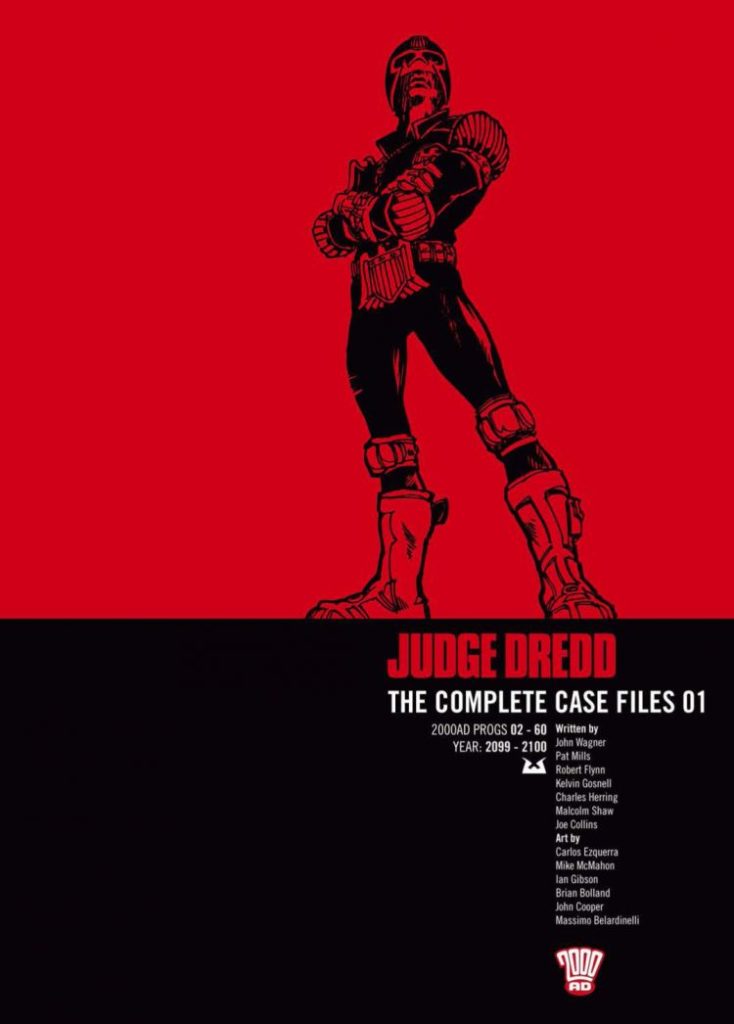
Judge Dredd: The Complete Case Files
Of the books included in the Humble Bundle, the Judge Dredd case files were the only ones I had already read and I knew that they, by themselves, were well worth the $20 asking price several times over. The bundle includes the first five volumes and there are several all-time classics in these pages. While there are far two many good stories to list them all, especially notable are the series’ signature “mega-epics”, including such monumental stories as “The Cursed Earth” and “The Day the Law Died” in volume two, “The Judge Child” in volume four and the eye-wateringly epic “Block Mania” and “The Apocalypse War” in volume five (an event so momentous in the history of Judge Dredd that we’re still feeling the effects of it over 40 years later). Honestly, I’m underselling just how amazing these stories are because I just want you to go ahead and get them for yourself – they’re seriously that good!
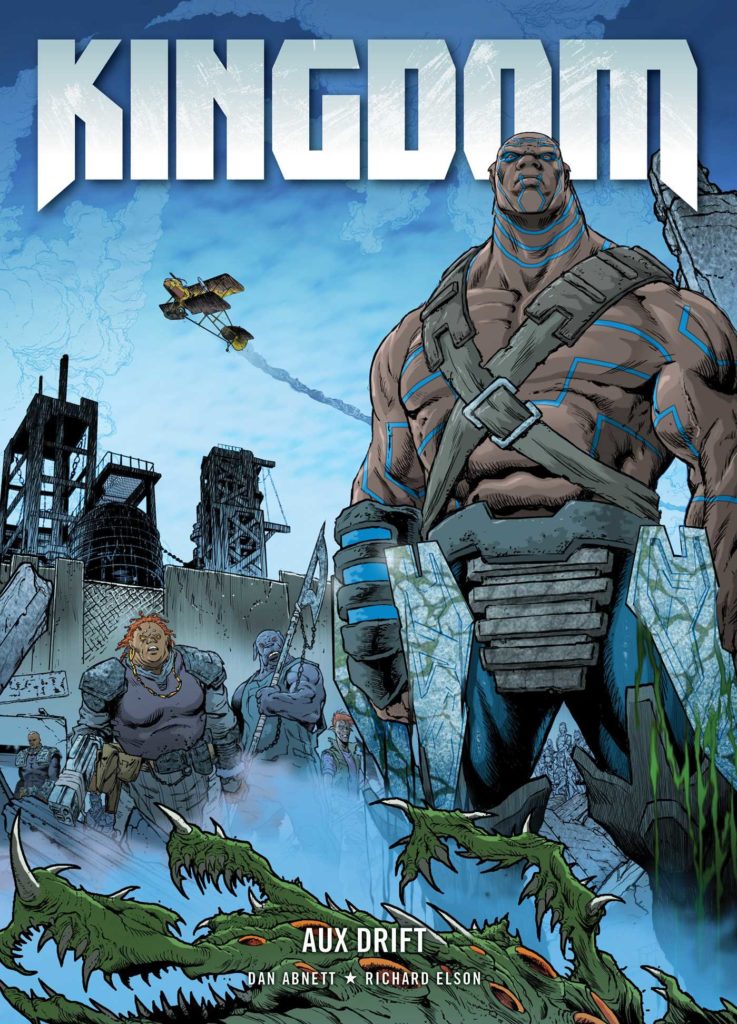
Kingdom
Oh hey, another story from the mind of Dan Abnett! Kingdom is a far different beast than Abnett’s other story in this bundle, Brink. Set in a world where giant insects have taken over the world, most of humanity has gone into cryo-sleep to allow genetically modified dog soldiers to win the war in their stead. We follow Gene the Hackman, an alpha male dog soldier who loses his pack and begins wandering around the world trying to repel Them. As you can probably tell, Kingdom is full of dog/soldier pop culture references, to the point where the giant insect antagonists are literally called “Them“. The story is also loaded with dramatic irony, largely revolving around the fact that Gene is kind of an idiot – like, he’s cunning but his understanding of the world is incredibly limited and he generally doesn’t bother to expand his horizons. In a particularly funny example, one of his dog soldier companions is put down for being too old to fight and a human tells Gene that he was taken away to a nice farm where he can run around and enjoy himself, a lie which Gene references throughout the series as a place he’d like to visit someday. This wry humour helps to keep Kingdom from getting too grimdark and makes it consistently enjoyable, while Abnett’s writing keeps the story engaging. There are four whole volumes of Kingdom in this bundle and by the time I got to the second one I was hooked. The scope becomes more expansive and complex as it goes, but my one main complaint would be that Abnett has a bad habit of resetting the cast of supporting characters at the start of each volume, which is more annoying and frustrating than anything.
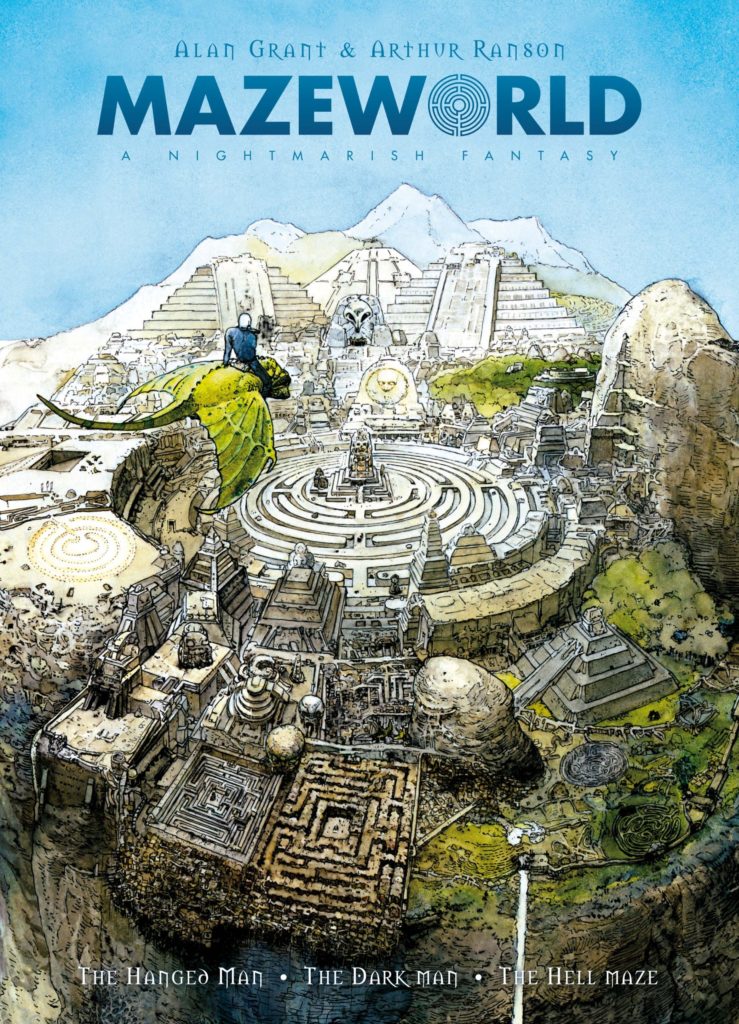
Mazeworld
Mazeworld is an intriguing self-contained story from Alan Grant and Arthur Ranson, the duo responsible for some of the best stories from volume two of Judge Anderson. Mazeworld largely succeeds due to its protagonist Adam Cadman, an unrepentant asshole on death row who learns to work with others and become a hero when he is transported to the titular Mazeworld. Cadman himself doesn’t change that much, merely his perception of himself – in Mazeworld he’s seen as a hero and so he attempts to live up to that reputation. The world itself is interesting, being built up of several mazes which the local populace lack the complete (or true) maps to, which helps the maze-lords keep control over them and Arthur Ranson’s art utilizes Aztec architecture which gives it an exotic and unconventional feel. However, the world itself isn’t particularly well sketched out, especially compared to a similar sort of high-concept fantasy setting like Brass Sun. The finale is also pretty underwhelming, it feels like Alan Grant wanted to make this a limited series and as a result rushed the ending instead of getting there naturally. The ending itself is certainly appropriate, but I feel like it could have been more satisfying if they had given it a bit more room to breathe. Still, Mazeworld‘s a fun, short read that leaves you feeling better about the potential of humankind.
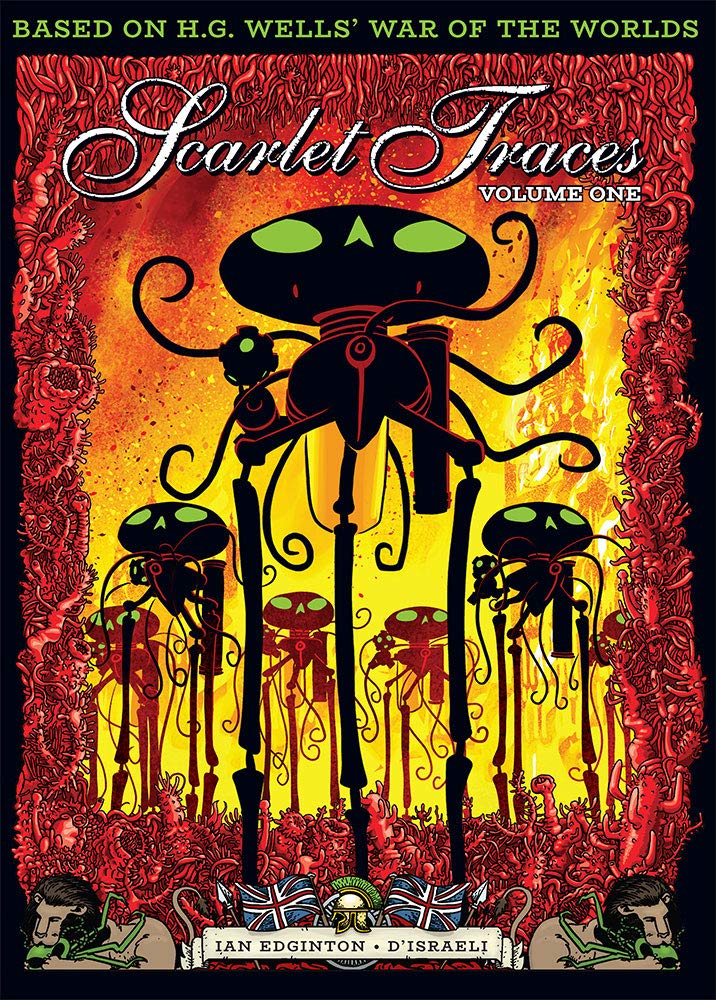
Scarlet Traces
We’re back with another Ian Edginton story, one which I’ve actually read a bit of in 2000AD already – Scarlet Traces, which acts as a companion piece, and eventually sequel, to The War of the Worlds. Featuring art from D’Israeli (for my money, one of the most distinctive artists at 2000AD), the humble bundle collects the first volume of the story along with Edginton and D’Israeli’s graphic novel adaptation of The War of the Worlds. This adaptation is fairly faithful to the source, if somewhat truncated, although it loses a lot of its literary significance in translation. That said, the first part of Scarlet Traces captures the sinister anti-colonial elements of the original novel far better, giving us a nice little pulp mystery which takes on a shockingly bleak and tragic tone as it goes along. Unfortunately, volume one ends just as things are getting truly interesting. There is a second volume available which I’ve purchased and I’ve already followed some of the newer issues in 2000AD, so I know this is a story that I’m really into but just be aware that the single volume in the bundle is but a tease of how good Scarlet Traces really is.
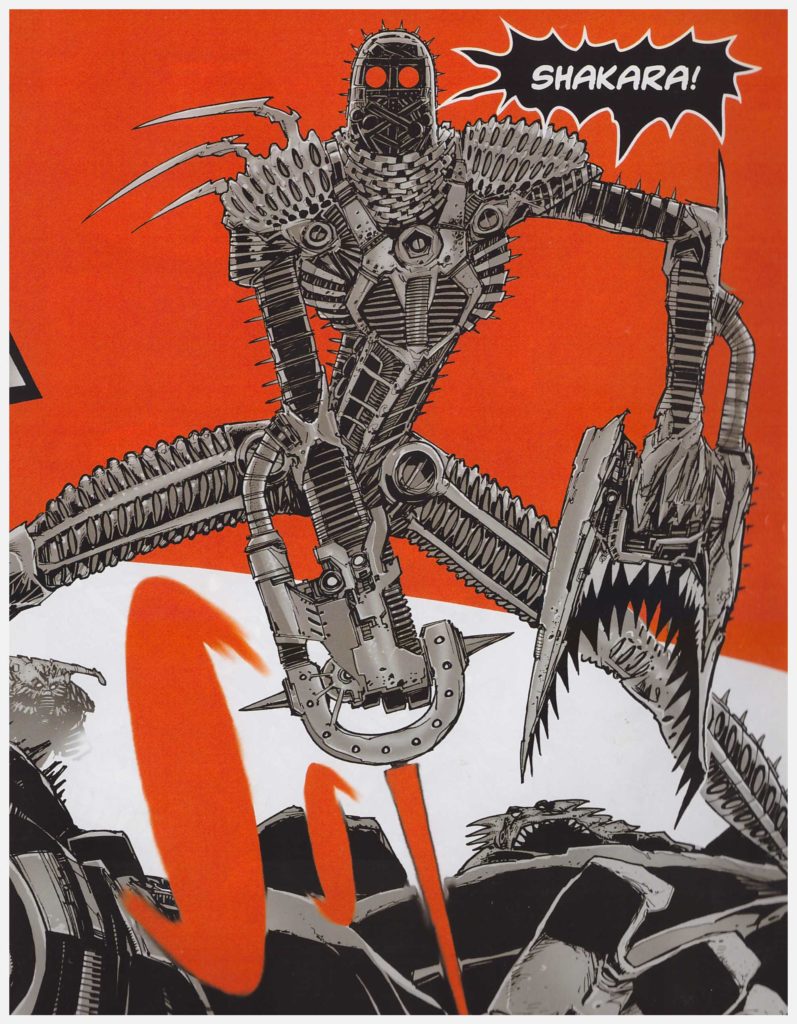
Shakara
Shakara is bonkers. To set the tone, the first page of the book has humanity and the Earth being destroyed unceremoniously, while the last surviving human, a defiant, would-be “hero”, has his head crushed in humiliating fashion just pages later. That’s barely scratching the surface of how insane Shakara gets though. The story follows a bio-mechanical alien who is basically John Wick in space, cranked up to 11. Like… seriously, everything about Shakara is so over the top that it’s brilliant. I’m talking over-the-top aliens (one species is basically a spinal column in a vat, another is a gaunt creature with a giant floating eyeball for a head, while yet another is a sentient dwarf galaxy), impossible planetoids and imaginative spacecraft (one psionic species literally flies around in giant brains). The out-there denizens of the story match just how insane the story itself is. The first act follows the titular Shakara as he interrupts galactic-scale atrocities and takes on entire armies single-handedly in his quest for vengeance. The second act has a team of equally over-the-top assassins being brought together to hunt down and kill Shakara. The third act has every mercenary in the freaking galaxy coming after Shakara… again, it’s basically like John Wick, with the story and world slowly being doled out over time. I love it, it’s such a joy to read and each panel just gets more and more imaginative as it goes along. Like many of these stories there’s a second volume available outside the Humble Bundle and you know I snatched that up before I had even finished the first volume.

Sláine
From what I understand, Sláine is something of a big deal in 2000AD, to the point where he has his own entire tab in the graphic novels section of the webstore. He’s basically an Irish version of Conan the Barbarian and has been with 2000AD since the 80s. I’ve never really read any of his stuff before now and… hoo boy, I have to say that I was really not into it. The Humble Bundle has two Sláine graphic novels included in it. The first is Warrior’s Dawn, a collection of Sláine’s original adventures which sees the titular character and his dwarf companion Ukko trying to make their way back north to reunite with Sláine’s love, Niamh. Warrior’s Dawn is… fine. It’s typical barbarian fantasy fare, with most of the entertainment coming from the constant bickering between the meat-headed Sláine and the unscrupulous Ukko.
If Warrior’s Dawn was the only Sláine story in the Humble Bundle then I would have been unimpressed, but the graphic novel entitled Book of Invasions vol. 1 completely turned me off all things Sláine. Set sometime looong after Warrior’s Dawn, Sláine has gone from a pulpy adventure story to thoroughly-unenjoyable, grimdark seriousness. It’s just so damn cliché, basically coasting off its grimdark tone and art style to try to appeal, but it did not work for me at all. Clint Langley’s art really leaves me mixed – on the one hand it has some of the most detailed and impressive work in the entire bundle. Langley’s style reminds me of Chrisopher Shy’s gorgeous work on the Dead Space graphic novels, not to mention that his work for Warhammer 40,000 is some of my favourite and really captures the horror of that setting well. However, there are times in Sláine where it is just ugly and feels like too much. When Sláine has a “warp-spasm” (translation: he hulks out) his muscles are exaggerated to such a ridiculous degree that I had to laugh at how stupid his tiny torso looked in comparison. To be fair, his warp-spasms have always looked stupid even in Warrior’s Dawn, but here they really clash with the more serious tone. It also does not help that the story itself is just a bunch of boring, grimdark barbarian clichés. Like, oh no, the demon army is only invading because they delight in raping the women and killing the children, how awful! The council of elders are dumb cowards, the only power that matters in this world is the sword and overwhelming violence! And spoiler alert, can you believe that Sláine goes on his quest for vengeance because the demons rape and murder his wife, Niamh? To make matters even worse, Ukko is basically shunted away in this story, so we don’t even get any sort of entertaining banter. Maybe Book of Invasions is just a shitty starting point to get into Sláine, but frankly I’m completely turned off by it. Like… at least I turned around on Bec & Kawl a bit by the end, Sláine was just a slog for me from start to finish. Book of Invasions is easily the worst story in the bundle and Warrior’s Dawn wasn’t much better. Maybe it’s just a matter of taste, but Sláine did not work for me at all.
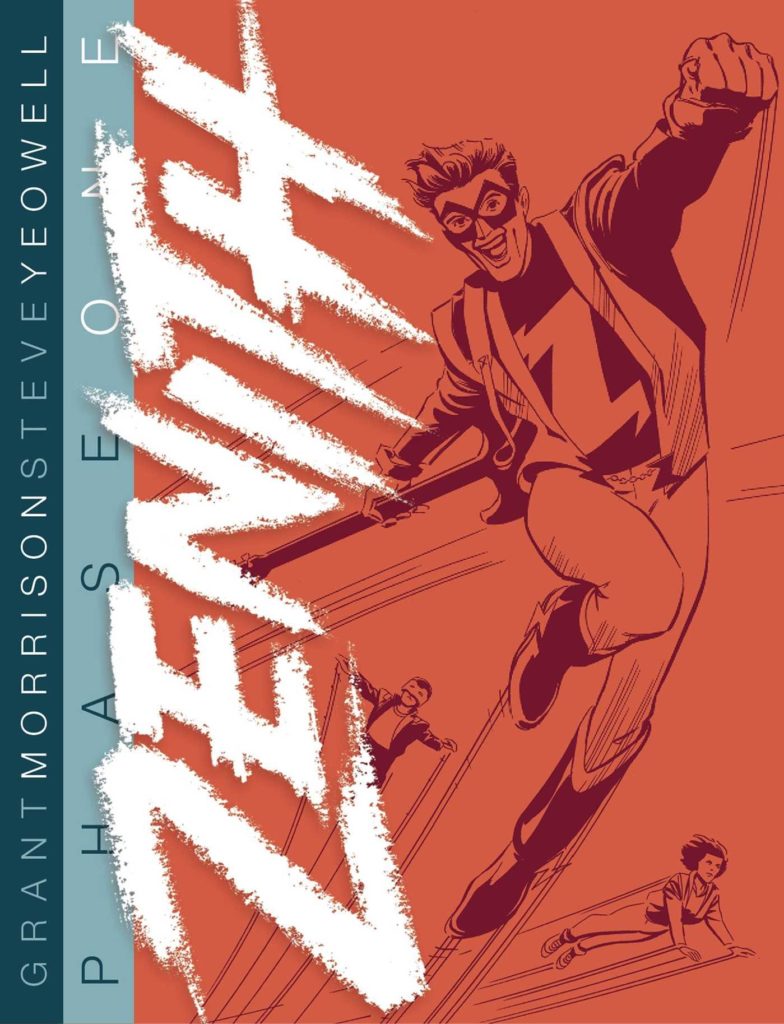
Zenith
Oh hey it’s another comic from an industry legend, Grant Morrison (who, I was recently informed by some dumbass on Twitter, sucks donkey balls… oh hey, and then another Twitter user informed me Morrison recently came out as non-binary, cool! As a result, I will be using they/them pronouns as they have requested). Zenith is a straight-up superhero comic, which is very unusual in the sci-fi and fantasy-dominated pages of 2000AD, and the Humble Bundle collects all four volumes of the story. It’s obvious that Phase One was written in the wake of industry titans Watchmen and The Dark Knight Returns, having been published just over a year after both landmark comics came out and shook up superhero narratives forever. It bears some resemblance to Watchmen in its narrative, taking place in an alternate-history timeline where superhumans fought on both sides of World War II, where an atomic bomb was dropped on Berlin and where the superheroes of the 60s have become washed-up shells of their former selves. The only hero still active is the titular Zenith, the only third-generation superhuman who happens to be a selfish, yuppie arsehole more interested in furthering his music career than helping people.
The most interesting thing in Zenith is the world Grant Morrison has created for his story. Finding out about the backstory of the first superhero, Maximan, learning about the second generation of heroes who refused to be tools of the government and instead joined the hippy movement, discovering that the second generation of superheroes have been lying about losing their powers, etc – personally I found this more interesting than the actual A-plot about Zenith dealing with life as a reluctant hero. The side-characters tend to be more interesting than Zenith as well. Washed-up superhero Siadwell Rhys (aka Red Dragon) spends most of Phase One an alcoholic, but Zenith helps to get him off the bottle and into fighting form to deal with a superpowered Nazi… only for him to instantly get one-shotted when they finally do battle. It’s a shocking and tragic moment because by that point Morrison had really gotten me to like Rhys before cruelly snatching him away. Peter St John (aka Mandala) is also fascinating in what he represents. Powers-wise he’s basically Mysterio and he was the ultimate hippy figure during the 60s. However, by the time Zenith takes place, he has fallen so far from his ideals that he has become a key politician in Margaret Thatcher’s conservative government! These generational commentaries are very clear throughout Zenith and are perhaps the most interesting aspect of the stories in my opinion.
All that said, the story starts to go a bit off the rails by the end of the second volume. Suddenly the story involves superheroes from hundreds of alternate dimensions teaming up to defeat the Lovecraftian Old Ones (literally, they name-drop them on a few occasions) and there are several dimension jumps, entire universes being destroyed and a bunch of new characters to keep track of. The art can also make it really hard to understand what’s going on, but Phase Three does give us a couple good twists and a brilliant splash panel of a robot riding a smiley face dinosaur into battle (which is as awesome as it sounds, even if it’s basically pointless in the actual story). Unfortunately, it also ends with an awful trans panic joke, which isn’t unusual for a comic written back in the 80s, but it’s disappointing none-the-less. Meanwhile, Phase Four is a disappointing conclusion. It finally reveals “The Plan” which has been teased for four whole volumes and it’s far more conventional than I had expected. This volume also tease a End of Evangelion-style apocalypse but doesn’t commit to it. Perhaps worst of all, Phase Four continues to just have Zenith as a passive actor within a story that is obstinately his own, making the whole endeavour feel kind of pointless. Zenith is just… strange. If you already know and like Grant Morrison then it might resonate with you, but I find it to be more interesting as a curiosity of a bygone era and a writer stretching himself rather than as a piece of entertainment on its own merits.
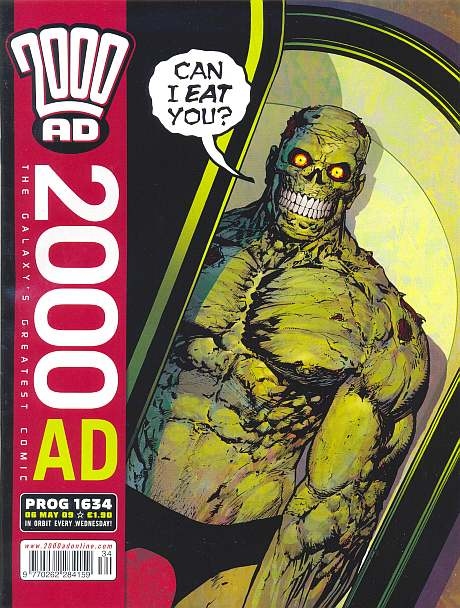
Zombo
Zombo wastes no time. Within a couple pages it has already set up its world, story and demonstrated its morbid sense of humour… which is to say that I dig it. The deadpan, dark humour is what really makes Zombo stand out. Sure, like any good piece of zombie media it’s loaded with gore, but how many other zombie stories have a half-human, half-zombie who asks if he can eat you? Zombo scratches the same sort of itch that Metalocalypse does for me, with stories about people getting stranded on a death world getting eviscerated in humourous ways, a suicide cult trying to make their deaths trend on a snuff version of Youtube, a half-zombie, half-bee hybrid called… Zom-bee, and Zombo having to fight his evil twin using the backup brain that’s been built into his ass. For all its dumb thrills though there’s some interesting commentary about putting too much trust in the government and an intriguing concept about the universe consciously pushing back against unchecked human expansion. The Humble Bundle collects the two volumes of graphic novels which have been released so far. I liked the first quite a bit and the second is also good but the second story in the second volume leans way too heavily on the same sort of referential humour that I hated in Bec & Kawl and really soured me on the whole thing. That said, if there was a third Zombo volume I probably would have bought it, so they clearly are doing something right.
And that does it for the stories in this Humble Bundle! There are definitely some great stories here and even at full price I’d recommend several of them wholeheartedly. That said, because I have an obsessive compulsion with ranking the things that I consume, here’s how I’d rank each collection in this bundle. Think of it as a quick-and-dirty recommendation list:
- Judge Dredd: The Complete Case Files
- The Ballad of Halo Jones
- Shakara!
- Brink
- Judge Anderson: The Psi Files
- Absalom
- Brass Sun
- Kingdom
- Scarlet Traces (This rank based purely on the limited volumes in the Humble Bundle; if I was counting the continued volumes then this would surely rank higher.)
- Defoe 1666
- 2000 AD‘s Greatest: Celebrating 40 Years of Thrill-Power!
- Zombo
- Aquila
- Mazeworld
- Zenith
- Age of the Wolf
- Counterfeit Girl
- The Best of Tharg’s Future Shocks
- Hope… For the Future
- Bec & Kawl
- Sláine